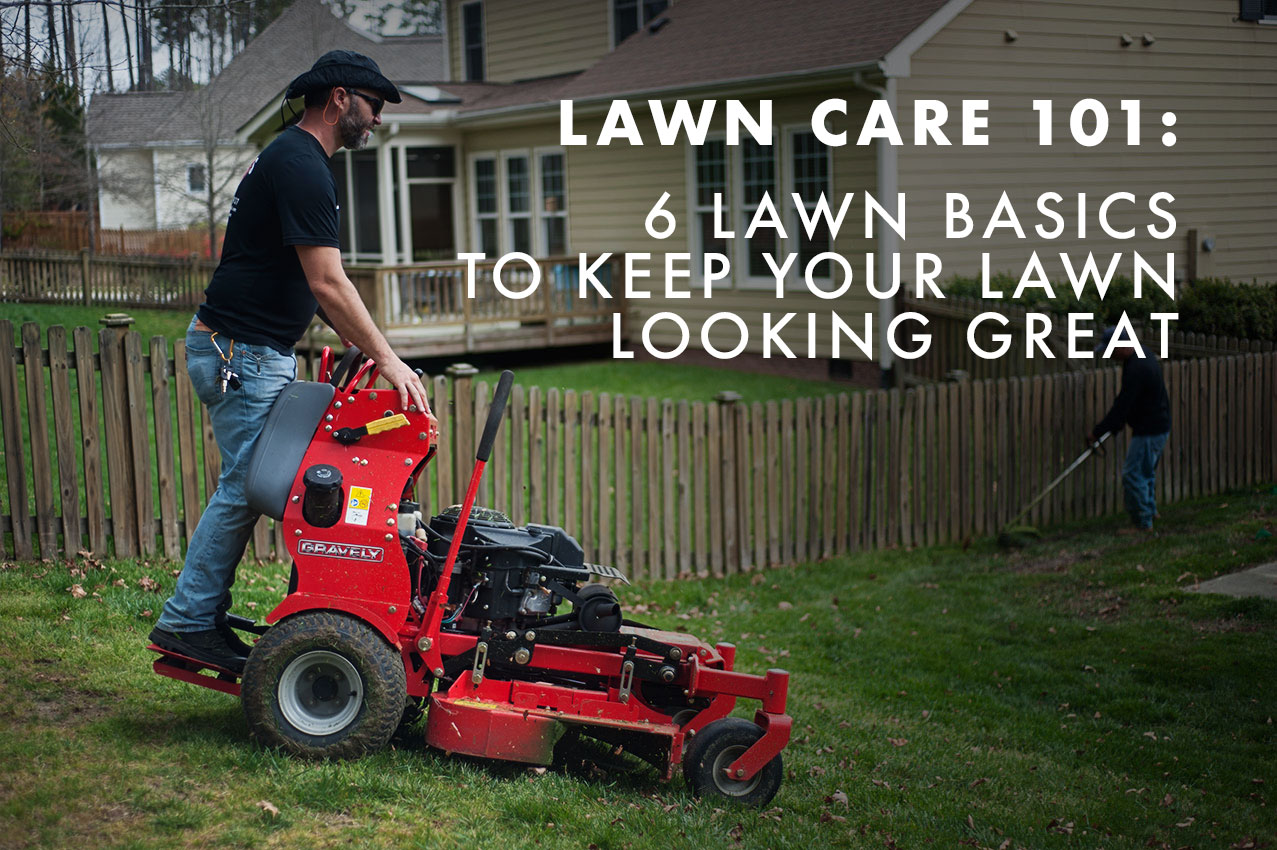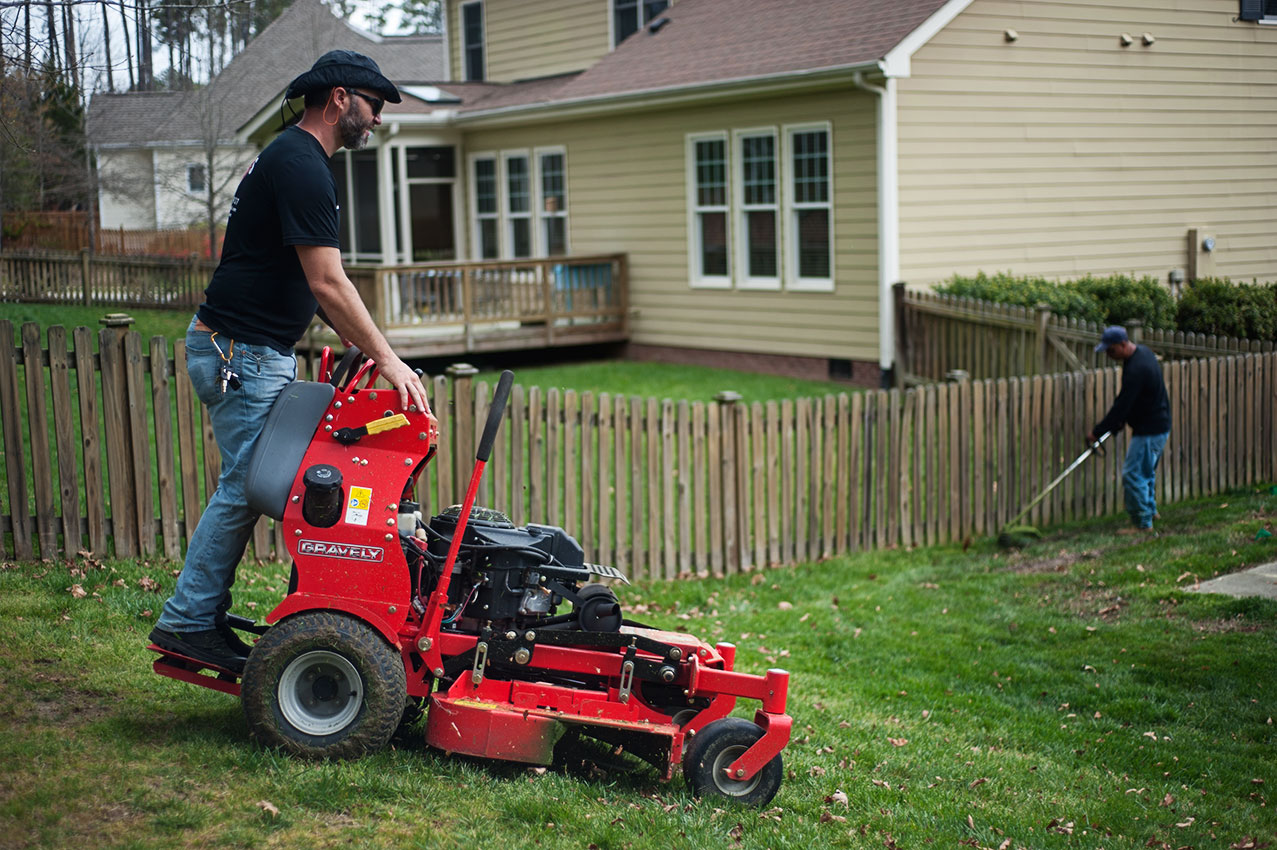
11 Jul Lawn Care 101: 6 Lawn Basics To Keep Your Lawn Looking Great
What is the point of taking care of your lawn? Maybe the answer is obvious to you, or maybe you’re not sure, but you know you are supposed to care. Perhaps you simply have some vague memory of your dad pushing the mower up and down the lawn on the weekends, being frustrated changing the string on the weed whacker or the old man on your street that yelled at any kid who dared get close to his pristine lawn.
Whatever is inspiring you to take an interest in your lawn, I believe you are making a great choice. Developing a healthy and beautiful lawn can fill you with pride and add value to your home.
The exact return on investment, or additional property value you get from maintaining your lawn and landscape can be hard to quantify, but there is a strong consensus that a happy and healthy lawn and landscape make for a positive first impression to potential home buyers.
Despite not being able to pin down an exact ROI on landscaping, a positive first impression of a home can mean the difference between a buyer driving by or stopping to take a closer look. – Jill Chodorov Kaminsky, The Washington Post
We can assume that you are convinced of the merit of maintaining your lawn since you have found your way here on your internet travels. Let’s get into the six basics to keeping your lawn looking great.
1. Getting To Know Your Lawn
Before we get into what it takes to actually take great care of your lawn, it is important to get to know your lawn.
Let’s start with how big your lawn is. This will affect what kind equipment you need to buy, how much water you need and how much fertilizer might be required. Of course you can get outside and do some measurements, but a quick and simple approach is to use Google Maps to measure the distance around your lawn.
Now that you know how big your lawn is, it’s time to figure out what kind of turf the lawn is made of. The type of grass in your lawn will have a lot to do with what part of the country you live in.
Cool Season grasses thrive right where you might expect, in the Northeast, Midwest and Pacific Northwest. Inversely, Warm Season grasses thrive in the South and Southwest. Here in North Carolina, we live in the Transition Zone, and enjoy the best and worst of both worlds.
What does this all mean? Sitting here on the internet, your guess is as good as mine. You need to get out in your lawn and take a look at the turf’s properties. You can use this guide through NC State University to help you to identify it.
If you decide you need some help, contact your local agricultural extension office or find a reputable lawn care and landscaping specialist near you. Kind of like yours truly–WINK.
2. Mow Your Lawn
Now that you know a little bit about your lawn, how do you cut it? This seems pretty simple, and it is, but there are a few things to know to help your lawn thrive and resist weeds and other pests.

To mow your lawn you will need a mower, trimmer and blower. Which of the thousands of these tools you need is going to depend a lot on your budget, the time you have to mow your lawn and the size of your lawn (See Above).
These are all going to be personal decisions based on your particular needs and I would not begin to tell you what to do. Just be practical and take care of your equipment so that it will last for many seasons.
One of the bigger decisions to make when cutting your lawn is at what height to set your mower. This is going to vary based on the type of turf on your lawn, but a good rule of thumb is to never remove more than one third of the total height. Why? Well… science, but in short, cutting your turf more than this puts a lot of stress on the grass and can lead to a weak root system or dead grass.
Once our lawn is cut to our desired height, it is time to edge it. Edging is simply cleaning up the edges of our lawn between it and any bed or hard surfaces, like sidewalks, and cutting any small areas of our lawn that we are not able to get with the mower.
Since you don’t want to spend a fortune on a bunch of specialty equipment, the easiest way to get this done is with a string trimmer. I can’t imagine that describing how to edge your lawn with a string trimmer in this post is going to be all that useful, so instead here is a link to a video (shout out to This Old House) showing you how. It will take practice, but after a little practice you should be off to the races.
Alright, we’ve mowed and edged, and our lawn is looking good, but the driveway, sidewalks and walkways are a mess from all of the clippings. What should we do with them? This is where our blower comes in. We blow all of our clippings back into the lawn. This makes our hard surfaces nice and clean and the clippings are mulched into our soil.
Not much to it, but cleaning off our hard surfaces brings the whole thing together and gives a whole lot of satisfaction.
3. Make Sure Your Lawn Gets Enough Water
Your lawn is a plant, or several at that, and plants need water to grow, survive and thrive. So, Boom! Let’s give it some water, but how?

Early in the morning is the best time to give your lawn a nice drink. Watering in the a.m. will help reduce the risk of disease, water loss through evaporation, and help with proper water distribution throughout your lawn.
You are watering in the early morning, but how much should you give your lawn and how often? Again, this is going to vary based on your region, turf type and season, and as always it is smart to talk to your Agricultural Extension Office.
Here in the Triangle of North Carolina, we generally recommend our clients give their lawns one to one and a half inches of water every seven days.
Your mileage will vary and if you are unsure, check with a the Ag Extension, a local pro or in some cases… the internet.
4. Feed Your Lawn
Just like you, your lawn needs food to grow and be healthy. What you feed it will depend on what it needs, and the only way to know that is to test it.
There are all manner of soil testers out there, but I recommend and use a soil probe. Soil samples are then sent off the the Ag Extension Office. You might notice a theme here. I am going to say this a bunch because it is important. Your local Agricultural Extension Office is an invaluable resource.
So, how much nitrogen, phosphorus or potassium does your lawn need? Or maybe you need to adjust the PH of your lawn with some lime? Once you have your results back from the Ag Extension, now is the time to do a little more work, potentially some internet research, and figure out the most effective treatments to your soil’s issues.
Where you get your nutrients from is a matter of preference as well. You can certainly go down to your local big box store and purchase some fertilizer, but if you are into a crunchier (read: hippie) approach, that is cool too. The important thing is giving your lawn the nutrients it needs to be its healthiest.
5. Pest Management & The Health of Your Lawn
You will not have a perfect lawn. You just won’t. There is no such thing, but that is okay. Pests of both critter and plant variety are a natural part of a lawn’s life. Our goal is not to eliminate them completely, but to prevent them from harming the health and success of our lawn.

The single easiest way to help your lawn fight off weeds is by doing everything else on our list. A healthy lawn is naturally resistant to pests. So, if you are mowing correctly, giving your lawn enough water and feeding it the nutrients it needs, pest management is going to be a whole heck of a lot easier.
Okay, now your lawn is healthy, you are doing all the right stuff, but you still have weeds and that is annoying. What’s next? You need to study. Seriously, taking care of pests in your lawn is tough business and knowing the right chemicals or techniques that are going to remedy whatever issue your lawn might be suffering from is only going to come from cracking a few books if you want to take care of it yourself.
The North Carolina Pest Management Manuals can be found through NC State University. If you aren’t lucky enough to live in our fine state, go to your Ag Extension Office, Or, you know, Google.
These books are great references to have no matter how much experience you have dealing with pest issues. I keep both the Core Manual and the Ornamental and Turfgrass Manual in my team’s truck at all times.Using these books is also how you study if you’d like to become a Certified Pesticide Applicator like me.
6. Aerate Your Lawn
What is aeration and what does it do (Say that in an Arnold voice)? That was stupid, I will stop. Forget I said that. So what is it? Aeration is basically just creating a bunch of holes in your lawn. That sounds weird, why would we want to do that?

The reason you want to create these little holes all over your lawn is to help curb the compaction of your soil, improves air exchange between the soil and the atmosphere, water uptake, fertilizer uptake, and help with thatch breakdown.
Those all seems like good reasons to me. So, how do we get it done? There are a lot of ways and it will depend on the size of your lawn and your budget. Here is a video on the youtubes from Home Depot on how to aerate your lawn.
Speaking of Home Depot… rent an aerator from Home Depot. There is no reason to purchase an aerator unless you are in my line of work. Renting is a great way to get the job done with minimal cost and headache. I don’t actually care if you go to Home Depot, but I have had success renting equipment from them in the past and they are generally everywhere.
What is our take away?
Is there more to lawn care? You bet, but this should be enough to get you off to the races and get your mind working.
The two big things I want to leave you with are:
- You can do it. You can take care of your lawn. It will take work and time, but you can do it.
- Ask for help. Big surprise here. Visit your local Agricultural Extension Office. It is amazing what a great resource it is. Seriously, do it!
Not everyone has the time or inclination to take on their lawn care and landscaping on their own, and that is okay. We are all unique flowers, finding our own path in this world. If you fall into that category, hire a qualified professional. That is what guys like me are here for. I love taking care of my client’s lawns, and I get a lot of satisfaction giving them the lawn of their dreams.


Sorry, the comment form is closed at this time.